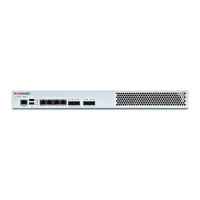Tunnel Routing Load Balancing & Fault Tolerance
According to example 1, any data sent from 1.1.1.11 (or 192.168.1.1-192.168.1.10) to 2.2.2.22 will be wrapped and
sent as a GRE packet. If 1.1.1.1 experiences a WAN link failure, the packet will still be sent from 3.3.3.3 to continue
the transfer.
NOTE: When using tunnel routing in FortiWAN, the settings must correspond to each other or else tunnel routing will
not perform its function. For example, if FortiWAN in Taipei has removed the values 2.2.2.2 to 3.3.3.3 in their routing
rule settings, then the FortiWAN in Taichung will not be operational.
Example 2: Tunnel Routing with Dynamic IP
A company operates a branch office oversea. In the headquarter, two WAN links are deployed: a fixed IP WAN and a
dynamic IP WAN; in the branch, two dynamic IP WAN.
Requirements
As illustrated in the diagram below, a tunnel is established between LAN1 and LAN2. Packets are transferred via two
WAN links evenly.
Summary of the Network
Headquarter Branch
WAN1 211.21.33.186 Dynamic IP
WAN2 Dynamic IP Dynamic IP
LAN 192.168.1.0/24 192.168.2.0/24
The settings for the headquarters:
Set the Local Host ID as HQ.
FortiWAN Handbook
Fortinet Technologies Inc.
110

